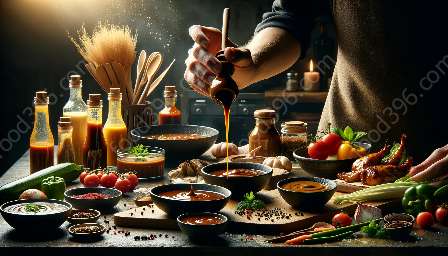Whether you're a seasoned chef or just starting out in the kitchen, the world of dips and dressings is a rich and flavorful one to explore. From classic recipes to inventive creations, there is always something new to learn and try. In this comprehensive guide, we'll delve into the art of sauce making, food preparation techniques, and much more, to help you master the art of creating delicious dips and dressings.
Understanding Dips and Dressings
Dips and dressings are an essential part of many cuisines around the world. They are used to add flavor, moisture, and texture to a wide variety of dishes, from appetizers and snacks to main courses and salads. Dips and dressings come in a myriad of flavors and consistencies, ranging from creamy and indulgent to light and tangy.
Understanding the basics of dips and dressings starts with recognizing the difference between the two. Dips are typically thicker in consistency and are meant to be scooped up with chips, crackers, or vegetables. They can be hot or cold, and savory or sweet. Dressings, on the other hand, are thinner and are used to coat and enhance the flavors of salads, meats, and vegetables.
Exploring Sauce Making
Sauce making is a culinary art that requires a keen understanding of flavors, textures, and techniques. From classic French sauces to modern innovations, the world of sauces is vast and varied. By mastering the art of sauce making, you can elevate your cooking to new heights and bring unique flavors to your dishes.
One of the most important aspects of sauce making is building layers of flavor. This can be achieved through the careful selection and preparation of ingredients such as herbs, spices, stocks, and aromatics. Whether you're making a velvety hollandaise sauce or a zesty salsa, balancing flavors and textures is essential for creating a harmonious and delicious sauce.
Key Techniques for Food Preparation
Food preparation techniques play a crucial role in the creation of flavorful dips and dressings. From chopping and blending to emulsifying and thickening, mastering these techniques will help you achieve the perfect texture and consistency for your creations.
One of the fundamental techniques in food preparation is emulsification, which involves combining two liquids that do not naturally mix, such as oil and vinegar, to create a smooth and creamy texture. Emulsification is essential for creating mayonnaise, vinaigrettes, and other creamy dressings. Another important technique is thickening, which can be achieved through the use of ingredients such as eggs, yogurt, or starches like cornstarch or flour.
Exploring Flavor Combinations
Creating delicious dips and dressings is all about experimenting with different flavor combinations. Whether you prefer bold and spicy flavors or light and herby notes, there are endless possibilities to explore.
Some classic flavor combinations for dips include ranch, buffalo, and spinach-artichoke, while popular dressings include vinaigrettes, creamy caesar, and balsamic glaze. However, the beauty of dips and dressings lies in their versatility, allowing you to customize and experiment with flavors to suit your taste and the dishes you're pairing them with.
Homemade Goodness
One of the most rewarding aspects of delving into the world of dips and dressings is the opportunity to create your own homemade versions. Homemade dips and dressings not only taste better than store-bought varieties, but they also give you complete control over the ingredients and flavors.
When making your own dips and dressings, you can tailor the flavors and textures to your liking and experiment with unique ingredients and flavor profiles. Whether you're making a classic hummus or a tangy mango salsa, the satisfaction of creating something from scratch is unparalleled.
Challenges and Solutions
While dips and dressings can be a delightful addition to any meal, they also come with their own set of challenges. From achieving the right balance of flavors to ensuring the perfect texture, here are some common challenges and solutions for making dips and dressings.
- Texture: Achieving the desired texture for dips and dressings can be challenging, especially when working with ingredients like yogurt, sour cream, or mayonnaise. To achieve a smoother texture, consider blending the ingredients for longer or adding a small amount of liquid to adjust the consistency.
- Flavor Balance: Balancing flavors is crucial for creating delicious dips and dressings. If a dip or dressing is too tangy, sweet, or spicy, consider adjusting the levels of acid, sweetness, or heat by adding small amounts of additional ingredients gradually until the desired balance is achieved.
Conclusion
From mastering the art of sauce making to exploring the world of dips and dressings, the culinary journey is as rewarding as the delicious creations that emerge from it. By understanding the intricacies of flavor combinations, food preparation techniques, and homemade goodness, you can elevate your culinary skills and bring a whole new level of flavor to your dishes.
Whether you're passionate about classic recipes or eager to experiment with innovative flavors, the world of dips and dressings offers a wealth of opportunities to explore and create. So, roll up your sleeves, gather your ingredients, and embark on a flavorful journey that is as diverse and delightful as the dips and dressings themselves.

